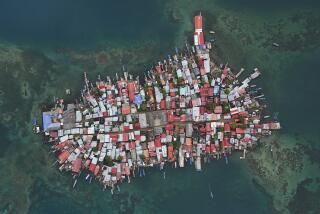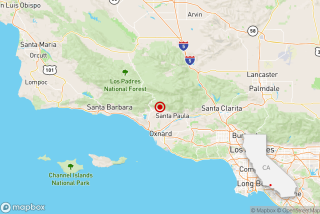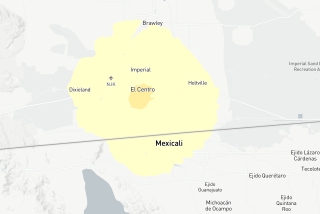Death Toll Grows to 75 From Earthquake in Central America; Thousands Homeless : Disaster: As many as 800 buildings were destroyed in one province. Roads, electricity and phones are disrupted.
SAN JOSE, Costa Rica — The number killed in Monday’s Costa Rican-Panamanian earthquake rose to 75 Tuesday, with thousands left homeless as a result of the strongest tremor to hit this country in 75 years.
The quake, particularly devastating to the Caribbean coastal areas, killed 46 people in Costa Rica, including three who died Tuesday when a quake-weakened wall collapsed on them, Red Cross officials said. Civil defense officials said 29 were killed in Panama. But officials in the two countries stressed that the count could go much higher.
Costa Rica’s National Emergency Commission said 350 injuries have been reported so far and as many as 10,000 people have been left homeless, mostly in the coastal province of Limon.
The tremor, which University of Costa Rica experts registered at a magnitude of 7.5 and which the Denver-based World Seismological Network estimated at 7.4, was felt throughout Costa Rica and in many parts of Panama at just before 4 p.m. Monday.
In Limon province, buildings were destroyed, bridges collapsed, electricity and water services were damaged or suspended, telephone communications were disrupted and many roads were blocked by landslides.
Dozens of the injured were being airlifted from the quake area to hospitals here in the capital.
However, authorities say they have been unable to reach victims in many isolated coastal communities and in the larger towns of Bribri and Sixaola near the border with Panama.
Authorities in Panama confirmed 288 injured in addition to the 29 dead in the coastal province of Bocas del Toro. Up to 800 buildings are said to have collapsed, and utilities have been severely disrupted.
A spokesman for Panama’s disaster relief organization described the situation in that country as “critical” and said 50% of all homes in the cities of Almirante, Changuinola, Guabito and California, all in Bocas del Toro province, were destroyed or severely damaged.
The provincial capital of Bocas del Toro, located on an island, was partly flooded, and local radio reports said the island of Cadenero was engulfed by a tidal wave.
Panamanian President Guillermo Endara decreed a state of national emergency and convened a meeting of his Cabinet to coordinate relief measures.
Nearly 200 hospital patients in the Panamanian city of David, in Chiriqui province, were evacuated when large cracks appeared in the building.
Here in Costa Rica, communities south of the city of Puerto Limon are isolated, officials said, and deep cracks up to 6 feet wide have appeared along the coastal road, hampering rescue work.
Aerial views broadcast on television showed widespread destruction in the Caribbean coast area, particularly around Puerto Limon. Film showed collapsed bridges, destroyed or severely damaged buildings and heaps of rubble.
Thousands in Limon province spent Monday night outdoors, fearing further quakes.
Several stretches of the 75-mile main road between the capital, San Jose, and the Caribbean coast were blocked by landslides.
Costa Rican President Rafael Angel Calderon decreed a national state of emergency Tuesday and visited the disaster zone to assess the damage.
He also appealed for international aid, and the United States, Britain, Nicaragua and Honduras were among those countries quick to respond.
The U.S. Southern Command in Panama sent a C-130 Hercules transport carrying 100 stretchers, emergency supplies and a group of seven surgeons and paramedics, plus two helicopters.
Britain is sending a group of 15 disaster relief experts, and the U.N. Organization for Central America has sent three helicopters. Neighboring Nicaragua has also contributed two helicopters, and Honduras is providing electricity.
The U.S. Embassy here said that no Americans were killed, injured or missing.
In Washington, White House Press Secretary Marlin Fitzwater said, “We will do all that is possible to assist Costa Rica and Panama to deal with this tragedy.”
He said the embassy has donated $25,000 for quake relief. In addition, he said, an assessment team from the Agency for International Development will help study the extent of the damage.
Humberto Trejos, president of Costa Rica’s National Emergency Commission, expressed the fear that extensive damage to water supplies might increase the risk of disease, particularly cholera.
When the earthquake struck Monday afternoon, thousands of people poured out of shops and offices and into the streets of San Jose.
In the capital’s crowded Plaza de la Cultura, several women fell to their knees and prayed while others grasped their children or huddled in groups. Most people appeared stunned, but a few screamed and burst into tears.
San Jose’s Holiday Inn Hotel, an 18-story building in the heart of the city, swayed heavily from side to side while people watched in horror from below.
Marcello Castro, the hotel’s reception desk manager, said he felt “a tremendous vibration” and that the building continued swaying for some time after the initial shock. The movement was such, he said, that he felt somewhat “dizzy, like being seasick.”
The quake occurred just two days before the 75th anniversary of the last Costa Rican temblor of comparable magnitude, according to Francisco Wendel, the director of the National University’s Volcanological and Seismological Observatory. The April 24, 1916 earthquake was centered in the Valle de Estrella.
Times staff writer James Gerstenzang in Washington contributed to this article.
More to Read
Sign up for Essential California
The most important California stories and recommendations in your inbox every morning.
You may occasionally receive promotional content from the Los Angeles Times.










